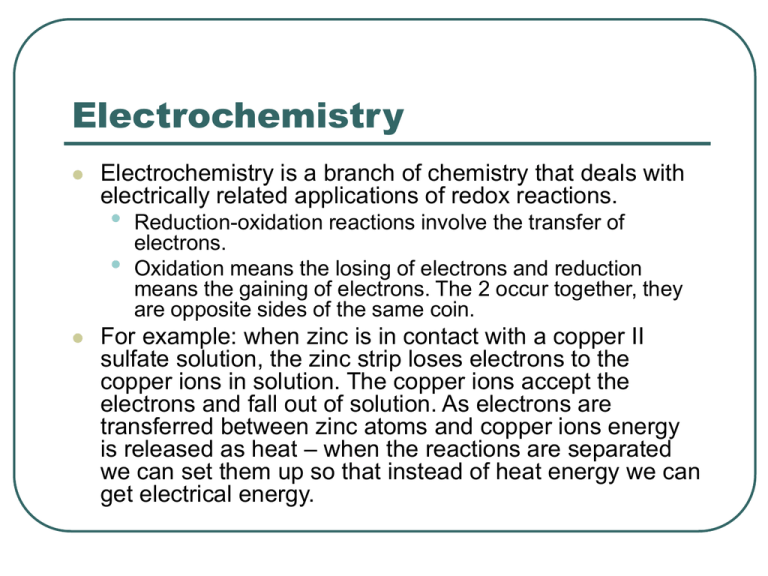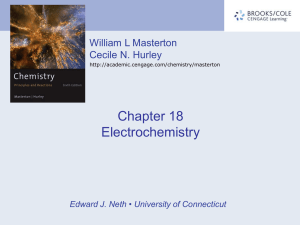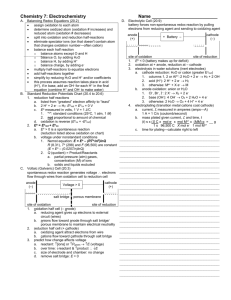Electrochemistry
advertisement

Electrochemistry Electrochemistry is a branch of chemistry that deals with electrically related applications of redox reactions. • • Reduction-oxidation reactions involve the transfer of electrons. Oxidation means the losing of electrons and reduction means the gaining of electrons. The 2 occur together, they are opposite sides of the same coin. For example: when zinc is in contact with a copper II sulfate solution, the zinc strip loses electrons to the copper ions in solution. The copper ions accept the electrons and fall out of solution. As electrons are transferred between zinc atoms and copper ions energy is released as heat – when the reactions are separated we can set them up so that instead of heat energy we can get electrical energy. Example 1 Net ionic equation: Zn (s) + Cu+2 (aq) Oxidation: Reduction: Cu (s) + Zn+2 (aq) Voltaic (Galvanic) Cells An electrochemical cell, such as a voltaic cell, consists of 2 electrodes. Each electrode is in contact with an electrolyte. The 2 electrodes are connected by a conducting wire or a circuit. And a porous barrier separates the 2 half reactions (or half cells). A voltaic cell specifically deals with a spontaneous redox reaction as the source of energy. It converts chemical energy into electrical energy. How it works…… In the “wet” voltaic cell represented in the previous slide an electric current can run through an external connecting wire so that the electric current moves in closed loop path (closed circuit). The electrode where oxidation occurs is called the anode. The electrode where reduction occurs is called the cathode. The 2 half-reactions occur at the same time but in different places at the cell (the porous barrier separates them). A salt bridge is necessary to keep the half cells electrically balanced so that a charge does not build up in the cell and stop the electrochemical reaction prematurely – this salt bridge allows for the passage of ions in the cell. ANode, OXidation; REDuction, CAThode AN OX and a RED CAT: Zinc & Copper Cell Notation When these cells are represented they are written as follows: Anode electrode anode solution cathode solution cathode electrode Example 2: Write the cell notation for the following reaction: Zn (s) + Cu+2 (aq) Cu (s) + Zn+2 (aq) Zn(s)|Zn2+ (aq) || Cu2+ (aq) | Cu(s) Inactive Electrodes graphite| I−(aq) | I2(s) || H+(aq), MnO4−(aq), Mn2+(aq) |graphite Practice Problems • • • • Write the half reaction in which I- (aq) changes to I2 (s). Identify if this occurs at the anode our cathode. Nickel solid is oxidized in to Ni+2 ions in a voltaic cell while the Cu+2 ion are being reduced in to copper solid atoms. Write the half reactions Write the net ionic equation Identify the anode and cathode Write the cell notation Cell Voltage The cell voltage from a redox reaction is referred to as the standard voltage, Eo (unit volts, V). • Standard conditions are 1 atm and 1 M solutions • Example 3: Zinc metal is placed in hydrochloric acid. Zinc is the anode and hydrogen gas forms at the cathode. The reaction gives off a standard voltage of 0.762 V. Write the net ionic equation for this reaction: Standard Voltage When calculating the standard voltage the standard voltage from the reduction and oxidation reactions must be considered. So when calculating the standard voltage you must use the following formula: Eo = Eored + Eoox Standard Potentials The standard half cell (half redox reaction) voltages are referred to as standard potentials and are used to calculate the standard voltage. Standard Reduction Potentials (one of your equation sheets) • This table gives the standard reduction potentials, the standard oxidation potentials are the same magnitude but the reverse sign. When Calculating Cell Voltage When calculating cell voltages there are 2 main points to remember: • 1. the calculation of E , is always a positive • quantity for a voltaic cell (spontaneous reaction). 2. The standard cell voltage is independent of how the equation for the cell reaction is written. This means you must never multiply the voltage by the coefficients used to balance the chemical equation. Example Example 4: Use standard reduction potentials to calculate the standard voltage for the ZnH+ cell from example 3. The Pain of a Dental Voltaic Cell • Have you ever felt a jolt of pain when biting down with a filled tooth on a scrap of foil left on a piece of food? Here’s the reason. The aluminum foil acts as an active anode (E° of Al = − 1.66 V), saliva as the electrolyte, and the filling (usually a silver/tin/mercury alloy) as an inactive cathode. O2 is reduced to water, and the short circuit between the foil in contact with the filling creates a current that is sensed by the nerve of the tooth. Finding Eored or Eoox If the standard voltage and the cell voltage from either the reduction or oxidation reaction the other maybe found by a simple rearrangement. • Example 4: If the standard voltage gathered from the standard Zn-Cu+2 cell is 1.101 V and the Eoox = 0.762 V, then find the Eored. Reducing & Oxidizing Agents If a species undergoes reduction (gains electrons) then it is the oxidizing agent. If it undergoes oxidation (loses electrons) then it is the reducing agent. The stronger the attraction for electrons the stronger the oxidizing agent. Or if using the standard reduction potentials, the more positive the Eored the stronger the oxidizing agent (oxidizing strength would be the opposite if using the reduction potential table). Cell Voltage Gibbs Free Energy & Equilibrium Standard cell voltage and standard free energy are related by the following equation: Go = -nFEo • When Go < 0 and Eo > 0 the reaction is spontaneous. Standard cell voltage and equilibrium are related by the following equation: Eo = RTlnK nF or at standard conditions (25o C) Eo = 0.0257 V lnK n • When K > 1 the reaction is spontaneous Effect of Concentration Voltage will increase for a reaction if the concentration of the reactants is increased or that of the products is decreased. This makes the reaction more spontaneous. Voltage will then decrease if the concentration of the reactants is decreased or that of the products is increased. This makes the reaction less spontaneous. The Nernst Equation Offers a quantitative relationship between cell voltage & concentration: E = Eo - RT lnQ nF or at standard conditions (25oC) E = Eo - 0.0257 V lnQ n Interpreting Q • If Q > 1 - concentration of the products are high so E < Eo (meaning lnQ is positive) • If Q < 1 - concentration of the reactants are high so E > Eo (meaning lnQ is negative) • If Q = 1 - reaction at standard conditions for cell voltage so E = Eo (meaning lnQ = 0) Electrolytic Cells An electrolytic cell is a non-spontaneous redox reaction that made to occur by pumping electrical energy into the system. When carried out in an electrochemical cell this is referred to as electrolysis. This is the procedure used when electroplating. Electrons are pushed into the cathode and removing them from the anode. Quantitative Relationships Quantitative relationships between the amount of electricity passed through an electrochemical cell: For the reaction Cu+2 (aq) + 2e- Cu (s) 2 mol e- = 1 mol Cu (s) = 63.55 g Cu • Coloumb (C) – the quantity of electrical charge (or electrical current). • 1 mol e- = 9.648 x 104 C • Determining Current flow: • Joule (J) – the amount of electrical energy, 1 J = 1 C*V I = q/t • Ampere (A) – unit for the rate of current flow, (1 A = 1 C/s) • Current (C) over time (s) Electrochemistry Stoichiometry From left to right, Walther Nernst, Albert Einstein, Max Planck, Robert Millikan, and Max von Laue. FRQ #1 It is observed that when silver metal is placed in aqueous thallium(I) fluoride, TlF, no reaction occurs. When the switch is closed in the cell, the voltage reading is +1.14 V. (a) Write the reduction half-reaction that occurs in the cell. (b) Write the equation for the overall reaction that occurs in the cell. (c) Identify the anode in the cell. Justify your answer. (d) On the diagram above, use an arrow to clearly indicate the direction of electron flow as the cell operates. (e) Calculate the value of the standard reduction potential for the Tl+/Tl halfreaction. The standard reduction potential, E°, of the reaction Pt2+ + 2 e− → Pt is 1.20 V. (f) Assume that electrodes of pure Pt, Ag, and Ni are available as well as 1.00 M solutions of their salts. Three different electrochemical cells can be constructed using these materials. Identify the two metals that when used to make an electrochemical cell would produce the cell with the largest voltage. Explain how you arrived at your answer. (g) Predict whether Pt metal will react when it is placed in 1.00 M AgNO3(aq). Justify your answer. FRQ #2 2 H2(g) + O2(g) 2 H2O(l) In a hydrogen-oxygen fuel cell, energy is produced by the overall reaction represented above. (a) When the fuel cell operates at 25˚C and 1.00 atm for 78.0 minutes, 0.0746 mol of O2(g) is consumed. Calculate the volume of H2(g) consumed during the same time period. Express your answer in liters measured at 25˚C and 1.00 atm. (b) Given that the fuel cell reaction takes place in an acidic medium, • • • (i) write the two half reactions that occur as the cell operates, (ii) identify the half reaction that takes place at the cathode, and (iii) determine the value of the standard potential, E˚, of the cell. (c) Calculate the charge, in coulombs, that passes through the cell during the 78.0 minutes of operation as described in part (a). FRQ #3 An external direct-current power supply is connected to two platinum electrodes immersed in a beaker containing 1.0 M CuSO4(aq) at 25˚C, as shown in the diagram above. As the cell operates, copper metal is deposited onto one electrode and O2(g) is produced at the other electrode. The two reduction half-reactions for the overall reaction that occurs in the cell are shown in the table below. (a) Half-Reaction E0(V) O2(g) + 4 H+(aq) + 4 e- 2 H2O(l) +1.23 Cu2+(aq) + 2 e- Cu(s) +0.34 On the diagram, indicate the direction of electron flow in the wire. (b) Write a balanced net ionic equation for the electrolysis reaction that occurs in the cell. (c) Predict the algebraic sign of ∆G˚ for the reaction. Justify your prediction. (d) Calculate the value of ∆G˚ for the reaction. An electric current of 1.50 amps passes through the cell for 40.0 minutes. (e) Calculate the mass, in grams, of the Cu(s) that is deposited on the electrode. (f) Calculate the dry volume, in liters measured at 25˚C and 1.16 atm, of the O2(g) that is produced.









